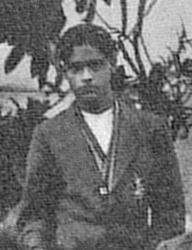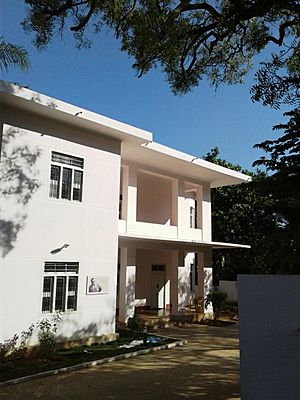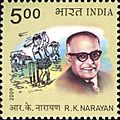R. K. Narayan facts for kids
Quick facts for kids
R. K. Narayan.
|
|
|---|---|
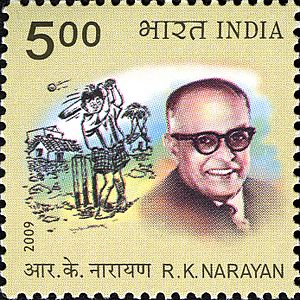
Narayan on a 2009 stamp of India
|
|
| Born | Krishnaswami Iyer Narayanaswami 10 October 1906 Madras, Madras Presidency, British Raj |
| Died | 13 May 2001 (aged 94) Chennai, Tamil Nadu, India |
| Occupation | Writer |
| Alma mater | Maharaja's College, Mysore |
| Genre | Fiction, mythology and non-fiction |
| Notable awards | Padma Vibhushan, Sahitya Akademi Fellowship, Benson Medal |
| Spouse |
Rajam
(m. 1934; |
| Children | 1, Hema Narayan |
| Relatives | R. K. Laxman (brother) |
| Signature | |
 |
|
| Member of Parliament, Rajya Sabha | |
| In office 12 May 1986 – 31 May 1992 |
|
Rasipuram Krishnaswami Iyer Narayanaswami (born October 10, 1906 – died May 13, 2001) was a famous Indian writer. He was known for his stories set in the made-up South Indian town of Malgudi. He was one of the first important Indian writers to write in English. Other famous writers of his time included Mulk Raj Anand and Raja Rao.
Narayan's friend and mentor, Graham Greene, helped him find publishers for his first four books. These included a series of three books that were partly about his own life: Swami and Friends, The Bachelor of Arts, and The English Teacher. The fictional town of Malgudi first appeared in Swami and Friends. His book The Financial Expert was praised as a very original work in 1951. The Guide, which won the Sahitya Academy Award, was even made into a film and a play.
Narayan's stories often showed the social life and daily routines of his characters. People have compared him to William Faulkner, another writer who created a fictional town and wrote about ordinary life with humor. Narayan's short stories are also compared to those of Guy de Maupassant because he could tell a lot in a short space.
Over his sixty-year career, Narayan received many awards. These included the AC Benson Medal from the Royal Society of Literature. He also received the Padma Vibhushan and the Padma Bhushan, which are two of India's highest civilian honors. In 1994, he received the Sahitya Akademi Fellowship, the top honor from India's national academy of letters. He was even chosen to be a member of the Rajya Sabha, which is the upper house of the Indian Parliament.
Contents
Life and Career
Early Life and First Steps in Writing
R. K. Narayan was born on October 10, 1906, in Madras (now Chennai, Tamil Nadu), British India. He grew up in a Tamil Brahmin family. He was one of eight children, with six sons and two daughters. His younger brother, R. K. Laxman, became a well-known cartoonist.
Narayan's father was a school headmaster. Narayan spent some of his childhood living with his grandmother, Parvati, because his father's job required moving often. During this time, his best friends were a peacock and a playful monkey. His grandmother gave him the nickname Kunjappa. She taught him math, mythology, Indian music, and Sanskrit. The family mostly spoke English at home.
Narayan went to several schools in Madras. He loved to read books by authors like Charles Dickens, P. G. Wodehouse, and Arthur Conan Doyle. When he was twelve, he joined a march for India's independence. His uncle was not happy about this, as the family usually stayed out of politics.
Narayan moved to Mysore to live with his family when his father was transferred there. He loved the school library and his father's books. He started writing his own stories. After high school, he didn't pass his university entrance exam the first time. He spent a year at home reading and writing. He passed the exam in 1926 and joined Maharaja College of Mysore.
After college, Narayan briefly worked as a school teacher. But he soon realized that writing was the only career for him. He decided to stay home and write novels. His first published work was a book review. He also wrote short stories for English newspapers. Even though he didn't earn much money at first, his family supported his choice to be a writer.
In 1930, Narayan wrote his first novel, Swami and Friends. His uncle made fun of it, and many publishers rejected it. But with this book, Narayan created Malgudi, his famous fictional town. Malgudi was a place that showed the social life of India. It changed and grew with India's history, both under British rule and after independence.
Marriage and New Beginnings
In 1933, while on vacation, Narayan met Rajam, a 15-year-old girl, and fell in love. Despite some challenges, he married her. After his marriage, Narayan worked as a reporter for a newspaper in Madras. This job helped him meet many different people and learn about various issues.
Around this time, Narayan's friend showed the manuscript of Swami and Friends to Graham Greene. Greene liked the book and recommended it to his publisher. The book was finally published in 1935. Greene also suggested that Narayan shorten his name to make it easier for English speakers. Swami and Friends was partly based on Narayan's own childhood.
His next novel, The Bachelor of Arts (1937), was inspired by his college days. It was about a rebellious young man who becomes a settled adult. His third novel, The Dark Room (1938), explored problems in marriage, showing the husband as controlling and the wife as a victim. Both books received good reviews. In 1937, Narayan's father passed away. Narayan had to take a job with the government of Mysore because he wasn't earning enough from writing.
In his early books, Narayan often highlighted social issues. Swami and Friends showed the difficulties students faced. The Bachelor of Arts looked at the tradition of horoscope-matching in Hindu marriages. The Dark Room discussed how wives often had to put up with their husbands' behavior.
Sadly, Rajam died of typhoid in 1939. This deeply affected Narayan. He never remarried and was very worried about their three-year-old daughter, Hema. This sad event inspired his next novel, The English Teacher. This book was very much like his own life, completing a series of three books that were partly about himself. Narayan later said that The English Teacher was almost entirely his autobiography, even though the characters had different names.
In 1940, Narayan tried to start his own magazine called Indian Thought. He got many subscribers, but he couldn't manage it, and it stopped after a year. His first collection of short stories, Malgudi Days, came out in 1942. The English Teacher followed in 1945. During World War II, it was hard to send books to England. So, Narayan started his own publishing company, also called Indian Thought Publications. This company was successful and is still run by his granddaughter today.
By 1948, Narayan's books were selling well, and he started building his own house in Mysore. It was finished in 1953. He also wrote a story for a film called Miss Malini (1947).
Busy Years and More Travels
After The English Teacher, Narayan's writing became more imaginative. His next book, The Financial Expert, was seen as a masterpiece in 1951. The idea for this novel came from a true story about a financial genius. His next novel, Waiting for the Mahatma, was loosely based on Mahatma Gandhi visiting Malgudi. It focused on a young man's love for a woman he meets at Gandhi's talks. The story mixed the Indian independence movement with the lives of ordinary people, told with Narayan's usual humor.
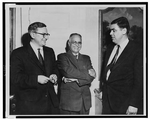
In 1953, Narayan's books were published in the United States for the first time. Even though his stories often showed strange things about society, Narayan himself was a traditional person. In 1956, he arranged his daughter's wedding following all traditional Hindu customs. After the wedding, Narayan started traveling more. He still wrote at least 1500 words every day, even when he was away from home.
He wrote The Guide while visiting the United States in 1956. During this trip, he kept a daily journal, which later became his book My Dateless Diary. Around this time, he met his friend and mentor Graham Greene in England for the only time. When he returned to India, The Guide was published. This book is a great example of Narayan's writing style, with its unclear ending. It won him the Sahitya Akademi Award in 1960.
Narayan also wrote essays, some of which were published in newspapers. Next Sunday (1960) was a collection of these essays. Soon after, My Dateless Diary, about his 1956 trip to the U.S., was published.
His next novel, The Man-Eater of Malgudi, came out in 1961. Critics praised its humorous story. After this book, Narayan traveled again, visiting the U.S. and Australia. He gave lectures on Indian literature. By this time, Narayan was very successful. He had a large house in Mysore and drove a new Mercedes-Benz. He also started writing columns for magazines like The Hindu and The Atlantic.
In 1964, Narayan published his first book about mythology, Gods, Demons and Others. It was a collection of short stories from Hindu epics, rewritten in his own style. His younger brother, R. K. Laxman, illustrated this book. After the book was released, Narayan traveled abroad again.
Narayan's next novel, The Vendor of Sweets, was published in 1967. It was partly inspired by his visits to America and showed the differences between Indian and American cultures. This year, he received his first honorary doctorate from the University of Leeds in England. He then had a quiet period for a few years.
In 1970, he published a collection of short stories called A Horse and Two Goats. Meanwhile, Narayan began translating the ancient Indian epic, the Kamba Ramayanam, into English. The Ramayana was published in 1973 after five years of work. Soon after, he started working on a shorter translation of another Sanskrit epic, the Mahabharata. While working on it, he also published The Painter of Signs (1977). This book was a bit different from his other works, as it touched on subjects like sex. The Mahabharata was published in 1978.
Later Years and Final Works
The government of Karnataka asked Narayan to write a book to promote tourism. This book was published as The Emerald Route (1980). It shared his personal thoughts on local history, but it didn't have his usual characters. In the same year, he became an honorary member of the American Academy of Arts and Letters and won the AC Benson Medal. Around this time, his books were translated into Chinese for the first time.
In 1983, Narayan published A Tiger for Malgudi, a novel about a tiger and its relationship with people. His next novel, Talkative Man, came out in 1986. It was about a journalist in Malgudi. He also published two collections of short stories: Malgudi Days (1982) and Under the Banyan Tree and Other Stories. In 1987, he finished A Writer's Nightmare, a collection of essays on various topics.
Living alone in Mysore, Narayan became interested in farming. He bought some land and tried growing crops. He also enjoyed walking to the market every afternoon, not just to buy things, but to talk to people. He would stop often to chat with shopkeepers, likely gathering ideas for his next book.
In 1980, Narayan was chosen to be a member of the Rajya Sabha, the upper house of the Indian Parliament. He served for six years. During this time, he focused on one main issue: the heavy school bags and how the education system affected children's creativity. This was a problem he first wrote about in Swami and Friends. His first speech in Parliament was about this issue. It led to a committee being formed to suggest changes to the school system.
In 1990, he published his next novel, The World of Nagaraj, also set in Malgudi. After finishing this book, Narayan became ill and moved to Madras to be near his daughter's family. A few years later, in 1994, his daughter died of cancer. His granddaughter, Bhuvaneswari (Minnie), then took care of him and managed Indian Thought Publications.
Narayan then published his last book, Grandmother's Tale. This book was a short story about his great-grandmother. She traveled far to find her husband, who had left shortly after their marriage. His grandmother had told him this story when he was a child.
In his final years, Narayan loved to talk. He would often spend evenings with N. Ram, the publisher of The Hindu, drinking coffee and talking late into the night. However, he stopped giving interviews. This was because of a bad experience with an interview for Time magazine, where he was taken around the city for photos that were never used.
In May 2001, Narayan was hospitalized. Just hours before he was put on a breathing machine, he was planning his next novel. It was going to be a story about a grandfather. He asked for a specific notebook, but he didn't get better. He passed away a few days later, on May 13, 2001, in Chennai, at the age of 94.
Literary Style
How Narayan Wrote
Narayan's writing style was simple and natural, with a gentle sense of humor. He wrote about everyday people, making them feel like your neighbors or cousins. This made it easy for readers to connect with his stories. Unlike other Indian writers of his time, he could write about the details of Indian society without changing his simple style. He also used dialogue that sounded like real conversations, with a hint of Tamil speech.
Critics have called Narayan the Indian Chekhov. This is because their writings are similar in their simplicity, beauty, and humor, even in sad situations. Graham Greene thought Narayan was more like Chekhov than any other Indian writer.
According to Pulitzer Prize winner Jhumpa Lahiri, Narayan's short stories are as captivating as his novels. Most of them are less than ten pages long and can be read quickly. Lahiri says that Narayan gives readers a full understanding of his characters' lives in just a few pages. She puts him among great short-story writers like O. Henry and Guy de Maupassant. Like Maupassant, Narayan could tell a complete story without using too many words. He often wrote about middle-class life with a clear and honest view.
Critics have noted that Narayan's writing is more descriptive than analytical. He used an objective style, which made his stories feel real. His way of looking at life helped him combine characters and actions. He could use ordinary events to create a strong connection with the reader. A big part of his writing style was his creation of Malgudi, a typical small town where old traditions and beliefs were common.
Narayan's writing style was often compared to William Faulkner's. Both writers showed the humor and energy of ordinary life and cared deeply about people. They also explored how society's rules clashed with individual feelings. While their approach was similar, their methods were different. Faulkner used long, complex sentences, while Narayan was very simple and realistic.
Malgudi: A Fictional Town
Malgudi is a made-up town in southern India that Narayan created. He came up with the town in September 1930, on Vijayadashami, a special day to start new things. He said that he first imagined a railway station, and then the name Malgudi came to him. The town had a rich made-up history, even dating back to the Ramayana days. It was also said that the Buddha visited Malgudi. Narayan never gave exact details about the town's physical layout. Instead, it took shape through the events in his many stories, becoming a familiar place for readers. A scholar named Dr. James M. Fennelly even drew a map of Malgudi based on the descriptions in Narayan's books.
Malgudi changed as India's political landscape changed. In the 1980s, when Indian towns were changing their British names, Malgudi's mayor tried to remove a statue of Frederick Lawley, an early resident. But when historical groups showed that Lawley had supported the Indian independence movement, the council had to put the statue back. Malgudi has been compared to Faulkner's Yoknapatawpha County. Just like in Faulkner's works, the town of Malgudi becomes clearer and more real as you read more of Narayan's novels and stories.
Awards and Honors
Narayan received many awards during his writing career. His first major award was the Sahitya Akademi Award in 1960 for The Guide. When The Guide was made into a film, he won the Filmfare Award for the best story. In 1964, he received the Padma Bhushan honor.
In 1980, he was given the AC Benson Medal by the British Royal Society of Literature. In 1982, he became an honorary member of the American Academy of Arts and Letters. He was nominated for the Nobel Prize in Literature many times but never won. In 1986, he was honored by the Government of Karnataka with the Rajyotsava Prashasti.
He also received honorary doctorates from the University of Leeds (1967), Delhi University (1973), and the University of Mysore (1976). Towards the end of his career, Narayan was chosen to be a member of the upper house of the Indian Parliament for six years, starting in 1989. This was for his important contributions to Indian literature. A year before he died, in 2000, he received India's second-highest civilian honor, the Padma Vibhushan.
Legacy
Narayan's biggest achievement was helping the rest of the world understand India through his writing. He is seen as one of the three most important Indian fiction writers in English, along with Raja Rao and Mulk Raj Anand. He gave readers something special with Malgudi and its people. He is considered one of the best novelists India has ever produced. He brought small-town India to his readers in a way that felt real and personal. Malgudi was not just a made-up town; it was full of unique characters, making it feel as familiar to readers as their own neighborhood. In 2014, Google celebrated Narayan's 108th birthday with a special drawing (doodle) showing him with a copy of Malgudi Days.
In 2016, Narayan's old home in Mysore was turned into a museum in his honor. The house was built in 1952. It was almost torn down by builders, but citizen groups and the Mysore City Corporation bought it back and restored it. The museum is free to enter and is open from 10:00 AM to 5:00 PM, except on Tuesdays.
On November 8, 2019, his book Swami and Friends was chosen as one of BBC's "100 Novels That Shaped Our World."
Works
- Novels
- Swami and Friends (1935)
- The Bachelor of Arts (1937)
- The Dark Room (1938)
- The English Teacher (1945)
- Mr. Sampath (1948)
- The Financial Expert (1952)
- Waiting for the Mahatma (1955)
- The Guide (1958)
- The Man-Eater of Malgudi (1961)
- The Vendor of Sweets (1967)
- The Painter of Signs (1977)
- A Tiger for Malgudi (1983)
- Talkative Man (1986)
- The World of Nagaraj (1990)
- Grandmother's Tale (1992)
- Non-fiction
- Next Sunday (1960)
- My Dateless Diary (1960)
- My Days (1973)
- Reluctant Guru (1974)
- The Emerald Route (1980)
- A Writer's Nightmare (1988)
- A Story-Teller's World (1989)
- The Writerly Life (2001)
- Mysore (1944, second edition)
- Mythology
- Gods, Demons and Others (1964)
- The Ramayana (1972)
- The Mahabharata (1978)
- Short Story Collections
- Malgudi Days (1942)
- An Astrologer's Day and Other Stories (1947)
- Lawley Road and Other Stories (1956)
- A Horse and Two Goats (1970)
- Under the Banyan Tree and Other Stories (1985)
- The Grandmother's Tale and Selected Stories (1994)
Adaptations of His Works
Narayan's book The Guide was made into a Hindi film in 1965, also called Guide. An English version was also released. Narayan was not happy with how the film changed his story. He wrote an article in Life magazine called "The Misguided Guide," criticizing the movie. The book was also turned into a play for Broadway in 1968.
His novel Mr. Sampath was made into a Hindi film in 1952. Another novel, The Financial Expert, became a Kannada film called Banker Margayya (1983).
Swami and Friends, The Vendor of Sweets, and some of Narayan's short stories were adapted into the television series Malgudi Days. This show started in 1986. Narayan liked these adaptations and praised the creators for staying true to his books.
Images for kids
See also
 In Spanish: R. K. Narayan para niños
In Spanish: R. K. Narayan para niños
- List of Indian writers


